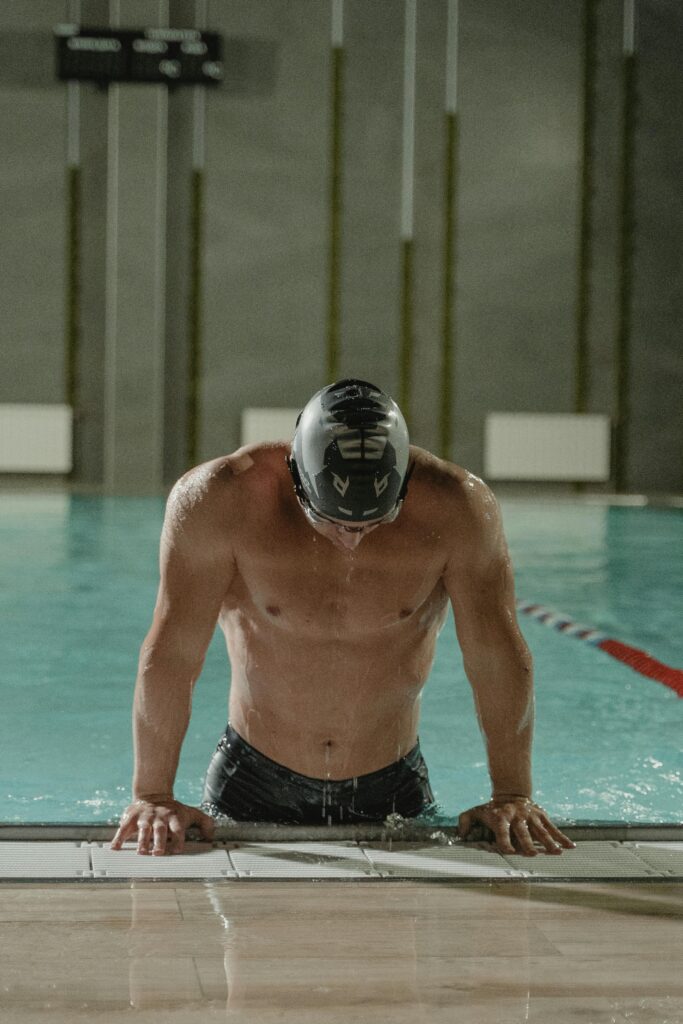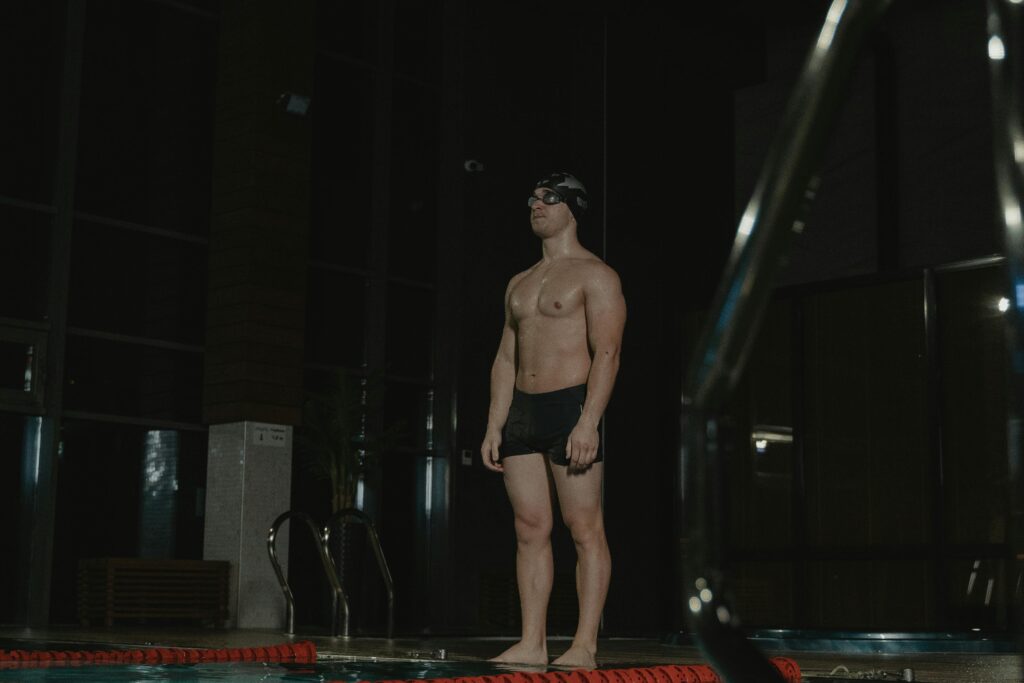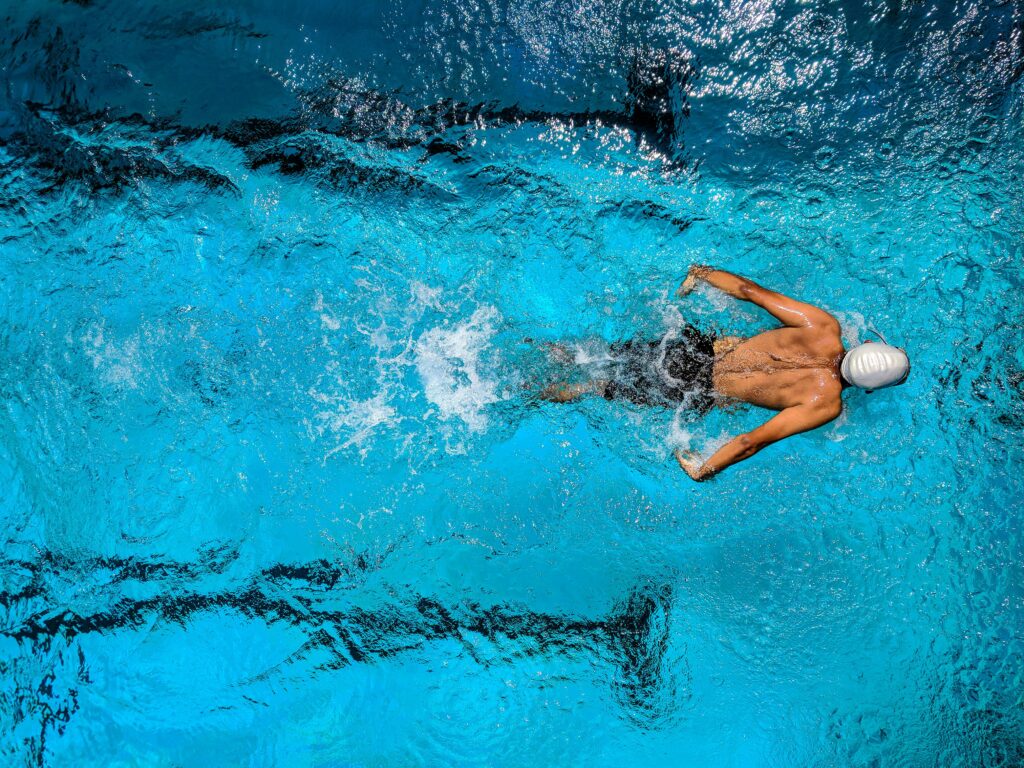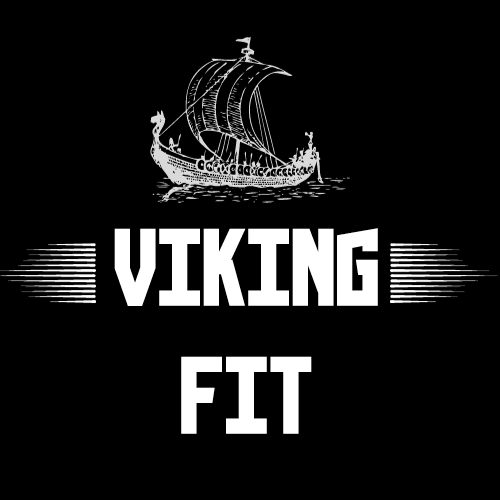Does swimming build muscle? The allure of a full-body workout in the refreshing waters may have you wondering about its muscle-building potential.
Interest: In this guide, we’ll explore the effectiveness of swimming as a muscle-building exercise. We’ll uncover the science behind swimming’s impact on muscle growth and provide insights to help you make the most of your aquatic workouts.
Desire: Imagine achieving your fitness goals while enjoying the invigorating experience of swimming. By understanding how swimming influences muscle development, you can tailor your workouts to maximize results and sculpt a lean, muscular physique.
Action: If you’re ready to dive into the depths of swimming and unlock its muscle-building benefits, join us as we unravel the truth about swimming’s impact on muscle growth.
Does Swimming Build Muscle ?

Table of Contents
Understanding Muscle Building
Whether you’re a seasoned gym-goer or just starting your fitness journey, grasping the fundamentals of muscle building is essential for achieving your fitness goals. In this article, we’ll delve deep into the science behind muscle growth, debunk common myths, and provide practical tips to help you maximize your muscle-building efforts. Let’s dive into the intricacies of muscle building and empower you to sculpt the physique you desire.
The Science Behind Muscle Building:
Muscle building, scientifically known as hypertrophy, is a complex process that involves a series of physiological adaptations in response to resistance training. When you subject your muscles to stress, such as lifting weights or performing bodyweight exercises, it triggers microscopic damage within the muscle fibers. This damage, along with proper nutrition and rest, prompts the body to repair and rebuild muscle tissue, resulting in increased muscle size and strength over time.
Understanding Muscle Fiber Types:
Muscles are composed of different types of muscle fibers, each with unique characteristics and functions. Understanding these fiber types is crucial for designing an effective muscle-building program. The two primary types of muscle fibers are:
- Slow-Twitch (Type I) Fibers: These fibers are highly resistant to fatigue and are primarily utilized during endurance activities such as long-distance running or cycling.
- Fast-Twitch (Type II) Fibers: These fibers are capable of generating more force but fatigue more quickly. They are recruited during high-intensity, explosive movements such as weightlifting or sprinting.
Principles of Muscle Growth:
Several key principles govern muscle growth and adaptation:
- Progressive Overload: Gradually increasing the intensity, volume, or resistance of your workouts is essential for stimulating muscle growth.
- Muscle Damage: Controlled muscle damage incurred during resistance training serves as a stimulus for muscle repair and growth.
- Metabolic Stress: Accumulation of metabolites within the muscle cells, such as lactate, during high-repetition, high-volume workouts can also contribute to muscle growth.
- Nutrition and Recovery: Adequate protein intake, along with proper nutrition and rest, is crucial for supporting muscle repair and growth.
Debunking Common Myths:
There are several misconceptions surrounding muscle building that warrant clarification:
- Myth: Women will bulk up from lifting weights.
- Myth: You can spot-reduce fat from specific areas of the body.
- Myth: Cardio is the best way to lose fat and build muscle simultaneously.
Practical Tips for Muscle Building:
To optimize your muscle-building efforts, consider incorporating the following tips into your training regimen:
- Prioritize Compound Exercises: Compound exercises, such as squats, deadlifts, bench presses, and pull-ups, target multiple muscle groups simultaneously and are highly effective for stimulating muscle growth.
- Focus on Proper Form: Maintaining proper form during exercises not only maximizes muscle engagement but also reduces the risk of injury.
- Ensure Adequate Protein Intake: Aim to consume around 1.6-2.2 grams of protein per kilogram of body weight per day to support muscle repair and growth.
- Get Sufficient Rest and Recovery: Allow your muscles time to recover and grow by prioritizing sleep and incorporating rest days into your training schedule.
- Does Swimming Build Muscle

The Role of Swimming
does swimming build muscle ? Swimming is not just a recreational activity; it’s a full-body workout that offers numerous physical and mental health benefits. In this comprehensive guide, we’ll explore the role of swimming in improving fitness, enhancing cardiovascular health, and promoting overall well-being. From its impact on muscle strength and endurance to its therapeutic effects on the mind, we’ll dive into the depths of swimming and uncover its multifaceted role in achieving optimal health and wellness.
The Benefits of Swimming:
Swimming offers a wide range of benefits for both the body and mind. Here are some of the key advantages:
- Full-Body Workout: Swimming engages multiple muscle groups simultaneously, providing a comprehensive workout for the entire body.
- Cardiovascular Health: Swimming is an excellent cardiovascular exercise that can improve heart health, lower blood pressure, and increase lung capacity.
- Low-Impact Exercise: Due to the buoyancy of water, swimming is gentle on the joints, making it suitable for individuals with joint pain or arthritis.
- Weight Management: Swimming burns calories and helps maintain a healthy weight, making it an effective exercise for weight management and fat loss.
- Stress Relief: The rhythmic movement and focus required while swimming can promote relaxation and reduce stress levels.
- Improved Flexibility: Swimming involves a wide range of motion, which can enhance flexibility and mobility in the joints and muscles. here is our top recommended workout at home with bench : Effective Exercises and Tips
Techniques for Effective Swimming:
To make the most of your swimming workouts, it’s essential to use proper technique. Here are some tips for improving your swimming technique:
- Focus on Form: Pay attention to your body position, breathing, and stroke technique to maximize efficiency and reduce drag in the water.
- Breathe Bilaterally: Practice breathing on both sides to maintain balance and symmetry in your stroke.
- Use Different Strokes: Incorporate various swimming strokes, such as freestyle, backstroke, breaststroke, and butterfly, to engage different muscle groups and prevent monotony.
- Interval Training: Alternate between different intensities and speeds during your swim sessions to challenge your cardiovascular system and improve endurance.
- Warm-Up and Cool Down: Start your swim workout with a gentle warm-up and finish with a cooldown to prepare your body for exercise and aid in recovery.
Tips for Safe and Enjoyable Swimming:
To ensure a safe and enjoyable swimming experience, consider the following tips:
- Start Slowly: If you’re new to swimming or returning after a long break, start with shorter sessions and gradually increase the duration and intensity of your workouts.
- Stay Hydrated: Drink plenty of water before, during, and after your swim to stay hydrated and maintain optimal performance.
- Use Proper Equipment: Invest in a well-fitting swimsuit, goggles, and swim cap to enhance comfort and performance in the water.
- Swim in Safe Environments: Choose swimming pools or open water locations with lifeguards on duty and adhere to safety guidelines and regulations.
- Listen to Your Body: Pay attention to how your body feels during swimming and adjust your intensity or duration accordingly to prevent overexertion or injury.
- Does Swimming Build Muscle

Does Swimming Build Muscle?
Does Swimming Build Muscle? The Truth Unveiled
Introduction: Swimming is renowned for its cardiovascular benefits and its ability to improve overall fitness. However, there’s often debate about whether swimming can effectively build muscle mass. In this comprehensive guide, we’ll delve into the science behind swimming as a muscle-building exercise. We’ll explore its potential to promote muscle growth, debunk common myths, and provide practical insights to help you maximize your swimming workouts for muscle development. Let’s dive into the depths of swimming and uncover the truth about its impact on muscle building.
while swimming may not be as effective as traditional resistance training for building muscle mass, it can still contribute to muscle development, especially for beginners or those seeking a low-impact workout. By incorporating intensity, variety, and supplemental dryland training, you can maximize the muscle-building potential of your swimming workouts. Remember to prioritize proper technique, nutrition, and recovery to support your muscle-building goals. So, dive into the pool with confidence, knowing that swimming can indeed play a role in your muscle growth in swimming .
Factors Influencing Muscle Growth in Swimming
Does Swimming Build Muscle ?, there are several factors at play that determine the effectiveness of muscle growth in swimming as a muscle-building exercise. In this comprehensive guide, we’ll delve into the various factors influencing muscle growth in swimming. By understanding these factors, you’ll be better equipped to optimize your swimming workouts for muscle development and achieve your fitness goals. Let’s explore the key factors that impact muscle growth in swimming.
- Stroke Technique:
The technique used while swimming greatly influences muscle engagement and activation. Each swimming stroke targets different muscle groups. For instance, the freestyle stroke primarily engages the muscles in the arms, shoulders, and chest, while the butterfly stroke emphasizes the muscles in the chest, shoulders, and core. Proper stroke technique ensures efficient muscle activation and maximizes the effectiveness of your swimming workouts. - Intensity and Duration:
The intensity and duration of your swimming workouts play a crucial role in muscle growth in swimming. the role of Swimming at higher intensities and for longer durations can provide a greater stimulus for muscle hypertrophy. Interval training, sprints, and endurance sets are effective strategies for challenging your muscles and promoting muscle growth. Incorporating varied intensities and durations into your swimming routine can help prevent plateaus and stimulate continuous muscle development. - Resistance Against Water:
Water provides resistance against movement, which can serve as a form of resistance training during swimming. The resistance offered by water increases muscular effort, particularly in the upper body and core. As you move against the resistance of water, your muscles work harder, leading to muscle fatigue and adaptation. This resistance stimulates muscle growth in swimming and strength development, especially when swimming at higher speeds or against currents. - Frequency of Workouts:
Consistency is key when it comes to muscle growth in swimming. Regular and frequent swimming workouts allow for progressive overload, where muscles are subjected to increasing levels of stress over time. By consistently challenging your muscles through swimming, you create an environment conducive to muscle hypertrophy and strength gains. Aim for a balanced swimming routine that includes both high-intensity sessions and recovery days to optimize muscle growth and recovery. - Nutrition and Recovery:
Proper nutrition and recovery are essential for supporting muscle growth in swimming and repair. the role of swimming Consuming an adequate amount of protein and carbohydrates before and after swimming workouts can replenish glycogen stores and provide essential amino acids for muscle recovery and growth. Additionally, prioritizing rest and recovery allows your muscles time to repair and rebuild, leading to greater muscle adaptation and growth. - The Importance of Nutrition: Nutrition serves as the foundation for fueling workouts, repairing muscle tissue, and supporting overall health. Key nutrients play specific roles in the muscle-building process and recovery, including:
- Protein: Essential for muscle repair and growth, aim to consume protein-rich foods such as lean meats, poultry, fish, eggs, dairy, legumes, and plant-based protein sources.
- Carbohydrates: Provide energy for intense workouts and replenish glycogen stores. Opt for complex carbohydrates like whole grains, fruits, vegetables, and legumes to sustain energy levels.
- Healthy Fats: Aid in hormone production and promote joint health. Incorporate sources of healthy fats such as avocados, nuts, seeds, and fatty fish into your diet.
- Hydration: Proper hydration is crucial for performance and recovery. Drink water throughout the day and consider consuming electrolyte-rich fluids during and after workouts, especially in hot environments or during intense sessions.
- The Role of Recovery: Recovery encompasses various strategies aimed at optimizing muscle repair, reducing fatigue, and preventing overtraining. Key components of an effective recovery plan include:
- Rest and Sleep: Allow adequate time for rest and prioritize quality sleep to facilitate muscle repair and recovery hormone production.
- Active Recovery: Engage in low-intensity activities such as walking, yoga, or swimming to promote blood flow, reduce muscle soreness, and enhance recovery between intense workouts.
- Nutrition Timing: Consume a balanced meal or snack containing protein and carbohydrates within the post-workout window (typically 30-60 minutes) to support muscle glycogen replenishment and protein synthesis.
- Foam Rolling and Stretching: Incorporate foam rolling and stretching exercises to improve flexibility, alleviate muscle tension, and enhance recovery.
- Practical Tips for Optimal Nutrition and Recovery: To maximize the benefits of nutrition and recovery in strength training, consider implementing the following tips:
- Plan and Prepare Meals: Prioritize nutrient-dense whole foods and plan meals and snacks ahead of time to support your training goals.
- Listen to Your Body: Pay attention to signs of fatigue, soreness, and hunger, and adjust your nutrition and training accordingly to prevent overtraining and promote recovery.
- Stay Consistent: Consistency is key to achieving long-term results. Aim to maintain a balanced diet and recovery routine consistently over time.
- Seek Professional Guidance: Consult with a registered dietitian or certified strength and conditioning specialist to develop a personalized nutrition and recovery plan tailored to your individual needs and goals.
- Conclusion: Incorporating proper nutrition and recovery practices into your strength training regimen is essential for maximizing performance, promoting muscle growth, and preventing injuries. By prioritizing nutrient-rich foods, implementing effective recovery strategies, and staying consistent with your habits, you can optimize your results and achieve your fitness goals more efficiently. Remember, success in strength training is not just about the intensity of your workouts but also about the quality of your nutrition and recovery practices

Practical Tips for Building Muscle Through Swimming
we’ll explore practical tips and strategies for this question Does Swimming Build Muscle? . From stroke techniques to workout routines, we’ll cover everything you need to know to make the most of your time in the pool and achieve your muscle-building goals. Let’s dive in!
- Perfect Your Stroke Technique:
Efficient stroke technique is essential for maximizing muscle engagement and minimizing energy wastage while swimming. Focus on proper form and technique for each stroke, such as freestyle, backstroke, breaststroke, and butterfly. Work on maintaining a streamlined body position, engaging your core muscles, and generating power from your hips and shoulders. - Incorporate Interval Training:
Interval training involves alternating between periods of high-intensity effort and recovery. Incorporating interval training into your swimming workouts can help boost muscle growth by challenging your muscles and increasing the overall intensity of your sessions. Try incorporating sprints or timed intervals of faster swimming followed by periods of slower recovery swimming. - Utilize Different Strokes:
Each swimming stroke targets different muscle groups, offering a well-rounded workout for your entire body. Incorporating a variety of strokes into your swim routine ensures that you engage different muscles and prevent overuse injuries. Experiment with different strokes, such as freestyle for the upper body, backstroke for the back and shoulders, breaststroke for the chest and legs, and butterfly for overall strength and coordination. - Increase Resistance:
Swimming against resistance is an effective way to build muscle strength and endurance. You can increase resistance by using equipment such as hand paddles, pull buoys, or resistance bands during your swim sessions. These tools add resistance to your movements, forcing your muscles to work harder and promoting muscle growth over time. - Focus on Strength Training:
While swimming is a fantastic full-body workout, supplementing your swim routine with dryland strength training exercises can further enhance muscle development. Incorporate exercises that target specific muscle groups, such as squats, lunges, push-ups, and pull-ups, to complement your swimming workouts and promote balanced muscle growth. - Prioritize Recovery:
Recovery is crucial for muscle growth and overall performance. Make sure to incorporate rest days into your workout schedule to allow your muscles time to repair and rebuild. Additionally, prioritize proper nutrition, hydration, and sleep to support muscle recovery and optimize your swimming performance.
Incorporating swimming into your fitness routine can be an effective way to build muscle, improve cardiovascular health, and enhance overall fitness. By following these practical tips and strategies, you can make the most of your time in the pool and achieve your muscle-building goals. Whether you’re a beginner or an experienced swimmer, remember to focus on proper technique, vary your workouts, and prioritize recovery for optimal results. So, grab your goggles and dive into your next swimming session with confidence, knowing that you’re on your way to building a stronger, more muscular physique.

Does Swimming Build Muscle ?
Conclusion
Swimming is not only a fantastic cardiovascular exercise but also a valuable tool for building muscle and improving overall strength. By incorporating the practical tips outlined in this guide, you can maximize your muscle-building potential in the pool and achieve your fitness goals more effectively.
Remember to focus on perfecting your stroke technique, incorporating interval training, utilizing different strokes to target various muscle groups, increasing resistance, and supplementing your swim routine with strength training exercises. Additionally, prioritize recovery by allowing your muscles adequate time to rest and repair, and fueling your body with proper nutrition and hydration.
Whether you’re a beginner or an experienced swimmer, these tips can help you take your workouts to the next level and transform your physique. So, dive in with confidence, embrace the challenge, and enjoy the rewards of building muscle through swimming. Your journey to a stronger, more muscular you starts now!
finally i think you the answer of the question does swimming build muscle ? and we know the benefits of swimming as well as the role of swimming if you interested another topic like this we recommending How to build muscle and lose fat in 2024 Full Guide For Beginners
thank you guys





Pingback: How to build muscle and lose fat in 2024 Full Guide For Beginners - vikingfit22.com
Pingback: female muscle growth A Comprehensive Guide - vikingfit22.com
Pingback: Crack Pre Workout - Vikingfit22.com